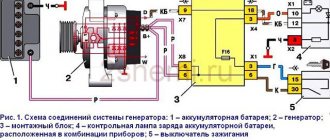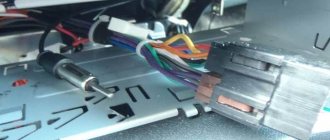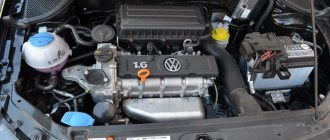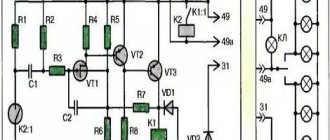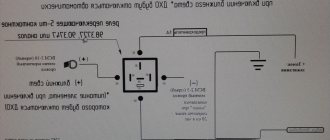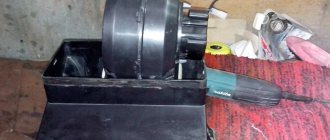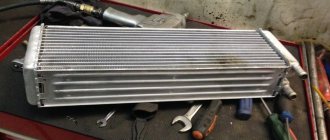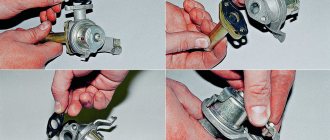What is a stove fan
A car heater, which is popularly called a stove, is designed to perform a simple and at the same time important function - heating the interior. In addition, the device helps eliminate fogging of windows in cold and damp weather. During normal operation of the heating system, the temperature in the interior of the “nine” should be maintained at +20 ˚С with the same indicators outside, but only with a minus sign. In the legs, with maximum heating mode, the value should be maintained at +25 ˚С. One of the important components of the stove, in addition to the radiator, is the fan. The purpose of this device, its malfunctions and repairs should be considered in more detail.
Purpose of the device
The purpose of the motor is to increase the efficiency of the heating system and air circulation in the car. Its operation is based on air intake from outside and its subsequent supply into the cabin through the radiator. As a result of the air flow passing through the heat exchanger, the air enters the cabin already warmed up.
Heater operation diagram: a - VAZ 2108; b - VAZ -2108–01: 1- fan impeller; 2 — air duct for heating the windshield; 3 — windshield heating flap; 4 — damper for heating the driver’s feet; 5 — central nozzle flap; 6 - central nozzle; 7- radiator; 8 — heater control damper; 9 — driver’s foot heating window; 10 - internal ventilation duct
Where is the motor located on the VAZ 2108/09
The heater motor on the VAZ 2108/09 is installed in a niche in the engine compartment in front of the windshield, which is radically different from the design of the heater of classic Zhiguli cars, which have a fan installed in the cabin. The unit is an electric motor with an impeller mounted on it, through which air is pumped into the cabin.
The heater motor on the VAZ 2108/09 is installed in a niche in the engine compartment in front of the windshield
Connection diagram
To make it easier to find possible faults with the fan, an installation diagram may sometimes be required, the main components of which are:
- fuse mounting block;
- egnition lock;
- additional resistor;
- fan motor;
- operating mode switch.
The heater motor connection diagram consists of a fuse mounting block, an ignition switch, an additional resistor, a fan motor, and an operating mode switch
Device elements
The stove on the VAZ-2106 includes the following main components:
- deflectors;
- stove tap rods;
- air intake covers;
- windshield air ducts;
- radiator;
- radiator casing;
- outlet pipes;
- underwater;
- stove tap;
- air distributor cover;
- electric fan motor;
- fan impeller;
- additional resistors;
- air ducts of the internal ventilation system;
- distributor cap lever;
- brackets;
- lid control handle;
- crane control handle;
- draft of the air supply cover.
These elements represent a heater device on a VAZ-2106 car.
Design and operating principle
The cabin heater on the VAZ-2106 car is a compact unit, the main components of which include:
- stove motor;
- fan with impeller;
- radiator;
- damper for air flow distribution;
- stove faucet with control levers.
IMPORTANT! If leaks were found in the radiator circuit of the VAZ-2106 stove, then, if possible, replace the radiator with a new one. Repairing it is difficult, plus it does not always bring positive results. This is more of a temporary measure.
The design of the stove on the VAZ-2106 car is quite simple, but for beginners, coping with the tasks of repairing it may be an impossible task. This is wrong. Especially if you are familiar with the device and design features of the heater.
- The standard, that is, factory heater for the VAZ-2106, has a relatively compact size, but effectively cools the liquid and warms up the interior. This is noted by many owners of domestic classics. Switching on and control is intuitive.
- The VAZ-2106 uses the most common heating system design among the Russian automobile industry, and in some places even the Soviet one. The basis is the liquid cooling system of the main engine.
- The main elements of the heating system are the stove, connections to control elements (faucets, levers), lines and a radiator.
- The heater dampers and valve are connected to the control device using an elastic and flexible rod.
- When the upper element is moved to the upper limit position, the valve opens completely, which ensures the maximum amount of coolant entering the heating system through the radiator.
- If the lower control device is moved to a similar position, then the air intake damper will be open to the limit. This way, maximum air flow will be directed through the stove into the heating system.
- Deflectors made of plastic can change the airflow angle in the VAZ-2106 cabin. Thus, the driver and front passenger regulate the direction of the air flows created during heating or normal ventilation.
- The air distribution cover is not connected to the heater control system switch. This damper allows you to adjust the degree of closing or opening using a lever device. This design provides additional comfort to the driver of the VAZ-2106 when regulating the operation of the heating system.
- The device includes a three-position toggle switch designed to regulate the volume of air flow passing through the stove. The regulator allows you to choose between two ranges of rotation of the heater fan - from minimum to maximum.
Heater fan VAZ 2108/2109
Breakdowns of the stove motor, although not so often, still occur. If this unit fails, the quality of heating is significantly reduced. Depending on the nature of the problem, extraneous noise may appear that distracts the driver's attention. In this situation, repair or replacement of the device is required, for which it must be removed from the car.
Reasons for failure
There are several common reasons that lead to fan problems.
Fuse
One of the likely reasons leading to a malfunction of the motor may be a faulty fuse. The element is located in a mounting block installed in the engine compartment in front of the windshield on the left side. It is worth starting troubleshooting by checking this part. The fuse is marked F7 and has a rating of 30 A.
The stove fuse is located in the mounting block marked F7 and has a rating of 30 A
Poor contact
Over time, contacts may oxidize. The check is not difficult; to do this, just move the block with the harnesses. If the fan starts working during the diagnostic process, then the cause has been found. The malfunction can be eliminated by cleaning the problematic contact in the mounting block.
During oxidation, the contact is usually covered with a green or white coating.
Resistor
The operation of the electric motor may be impaired due to problems with the additional resistor. At maximum speeds, the motor is connected to the power circuit directly, and at the first two speeds - through a resistor. If problems arise with this particular element, the electric motor will only operate in maximum mode. To replace the part located on the left side of the stove body, simply unscrew the fasteners and install a new resistor.
If the heater resistor fails, the heater will only operate at maximum speed
Switch
Sometimes problems may arise with the heater mode switch itself. The most likely cause is oxidized contacts (inside or outside) or the back of the part that has come loose from vibrations.
The contacts of the heater switch may oxidize or the back part may come off
In addition to the reasons listed, breakdowns of the electric motor itself are possible, for example, wear of the brushes. The same anchor can cause different problems:
If the windings short out, the heater fuse will blow, which will require repair or replacement of the fan.
How to remove the heater motor on a VAZ 2108/09
To dismantle the unit, you will need to prepare the following tools:
- Phillips screwdriver;
- head for 10;
- ratchet handle.
To remove the heater motor you will need a 10 mm socket, a Phillips screwdriver and a ratchet.
Then you can start removing the device:
- Raise the hood, unscrew the screws securing the plastic trim near the windshield and move it to the side.
To remove the plastic cover you will need to unscrew the corresponding fastener.
The hood seal can be removed with a simple hand movement
To get to the heater motor, you will need to remove the protective cover.
The fan is attached to the body with screws
To disconnect the fan circuit, you need to move into the cabin under the dashboard
To remove the electric motor, you need to rotate it in different directions.
Video: how to remove the heater motor
Disassembling and assembling the fan
After dismantling the motor, it is subjected to troubleshooting, for which the unit will need to be disassembled. We carry out the work in the following order:
- We separate the foam rubber seal from the electric motor casing.
Disassembling the fan begins by removing the seal from the housing
Remove the casing latches using a screwdriver
Device elements
The stove on the VAZ-2106 includes the following main components:
- deflectors;
- stove tap rods;
- air intake covers;
- windshield air ducts;
- radiator;
- radiator casing;
- outlet pipes;
- underwater;
- stove tap;
- air distributor cover;
- electric fan motor;
- fan impeller;
- additional resistors;
- air ducts of the internal ventilation system;
- distributor cap lever;
- brackets;
- lid control handle;
- crane control handle;
- draft of the air supply cover.
These elements represent a heater device on a VAZ-2106 car.
Design and operating principle
The cabin heater on the VAZ-2106 car is a compact unit, the main components of which include:
- stove motor;
- fan with impeller;
- radiator;
- damper for air flow distribution;
- stove faucet with control levers.
IMPORTANT! If leaks were found in the radiator circuit of the VAZ-2106 stove, then, if possible, replace the radiator with a new one. Repairing it is difficult, plus it does not always bring positive results. This is more of a temporary measure.
The design of the stove on the VAZ-2106 car is quite simple, but for beginners, coping with the tasks of repairing it may be an impossible task. This is wrong. Especially if you are familiar with the device and design features of the heater.
- The standard, that is, factory heater for the VAZ-2106, has a relatively compact size, but effectively cools the liquid and warms up the interior. This is noted by many owners of domestic classics. Switching on and control is intuitive.
- The VAZ-2106 uses the most common heating system design among the Russian automobile industry, and in some places even the Soviet one. The basis is the liquid cooling system of the main engine.
- The main elements of the heating system are the stove, connections to control elements (faucets, levers), lines and a radiator.
- The heater dampers and valve are connected to the control device using an elastic and flexible rod.
- When the upper element is moved to the upper limit position, the valve opens completely, which ensures the maximum amount of coolant entering the heating system through the radiator.
- If the lower control device is moved to a similar position, then the air intake damper will be open to the limit. This way, maximum air flow will be directed through the stove into the heating system.
- Deflectors made of plastic can change the airflow angle in the VAZ-2106 cabin. Thus, the driver and front passenger regulate the direction of the air flows created during heating or normal ventilation.
- The air distribution cover is not connected to the heater control system switch. This damper allows you to adjust the degree of closing or opening using a lever device. This design provides additional comfort to the driver of the VAZ-2106 when regulating the operation of the heating system.
- The device includes a three-position toggle switch designed to regulate the volume of air flow passing through the stove. The regulator allows you to choose between two ranges of rotation of the heater fan - from minimum to maximum.
IMPORTANT! Never turn on the electric heater fan if the air intake damper is in the retracted position and the valve is open.
Features of connecting the stove
The VAZ-2106 uses the Me 255 electric motor. This is a direct current electric motor that is excited by a permanent magnet. Several nuances of the VAZ-2106 heater connection diagram:
- When an additional resistor is connected to the electric motor supply circuit, the armature shaft begins to rotate, but at a lower frequency.
- The resistor is secured with a pair of spring washers inside the heater fan casing.
- At a temperature of 20 degrees, the resistor resistance is 1.5 ohms.
- If the electric motor fails, it should be replaced;
- Repair consists only of cleaning the commutator or applying lubricant to the bearings.
- Normally, the nominal voltage parameters in the circuit are 1 V.
- Rated power indicators - 2 W.
- The rotational speed of the electric motor shaft is 3000 rpm (under 12 V voltage conditions).
The heating equipment is relatively simple in its design and design, which is why most VAZ-2106 car owners prefer to carry out repairs themselves.
How does the heating system work in your car and does it often act up or require repair or maintenance? Share your impressions in the comments. It will be interesting to discuss current issues.
We check and repair the BA3 2109 stove
Interior heating is an important system, which, if it breaks down, can unexpectedly cause discomfort during the cold season. To prevent this, it is necessary that the 2109 stove is maintained in good condition. You should know how we get warm air into the cabin at the exit. Knowing the principle of operation of the engine cooling system and the electric heating ventilation drive, it is not difficult to repair the VAZ 2109 stove with your own hands.
At first glance, the interior heater seems to be a primitive device. Like, the car is driving towards the air flow, air is sucked in, somehow it is heated, and now it is already warm in the cabin. But it is not so. The stove is an auxiliary radiator for the engine cooling system, and air is pumped into the cabin using an electric drive. Therefore, let’s figure out how the stove receives heat from the cooling system and study its electrical circuit. Knowing this, you can identify malfunctions in the heater. Let's find out how to replace the VAZ 2109 stove fan with your own hands.
PROCEDURE FOR REPLACING THE VAZ 2106 HEATER
The vehicle interior is heated by engine coolant. The heater design details are shown in the diagram.
Many car enthusiasts only think about the heating system when it gets cold. But sometimes the heater can remind you of itself with an unpleasant smell in the cabin and the appearance of puddles of antifreeze under the feet of the driver or passenger in the front seat. This means that the heater core is leaking and needs to be replaced. This work can be done with your own hands.
Place of the heater in the engine cooling system
The stove is part of a closed vacuum coolant circulation system. The main purpose of this system is engine cooling. Thus, the design of the VAZ 2109 stove both helps to heat the interior in cold weather and cools the cylinder block when the engine is running. The entire SOD consists of:
- cooling jackets;
- radiator;
- expansion tank;
- water pump;
- radiator fan;
- thermostat;
- heating radiator - VAZ 2109 stove.
When driving, atmospheric air passes through the air intake into the radiator, the pipes of which contain air that is too hot for the engine. These pipes are cooled by a fan, and the already cooled liquid again enters the cooling jacket (cylinder block and cylinder head) through the water pump. The stove in this antifreeze cycle performs the task of additionally removing hot liquid.
The VAZ 2109 heating fan maintains the desired air temperature in the cabin.
The structure and operating principle of the VAZ 2106 heating system
The classic structure of the interior stove of the VAZ “Six” is as follows. Through the supply from the head cylinder block, its discharge set (consists of an electric motor, a fan and its impeller) and a heating unit (radiator plus control valve) are connected.
The operating principle of the system is simple.
- A running car engine heats up the antifreeze.
- The antifreeze circulating through the engine cooling system enters the heating system - the heater radiator.
- The intake air is driven through the cells by a fan.
- Heated air enters the cabin through air ducts.
- The antifreeze passed through the heating radiator passes back into the engine, thus constantly circulating and maintaining heat in the radiator.
Malfunctions of this unit can be different, but the most common ones are identified by specialists and experienced drivers:
- breakdown of the electric heater fan motor;
- faucet and radiator leaks.
It happens that cold air from the stove is caused by a lack of coolant in the system, then you just need to add it.
If the hose valve or radiator needs repair, if they need a complete replacement, it is necessary to dismantle and disassemble the stove. To do this, take simple tools and perform the following steps. Having opened the heater tap and drained the antifreeze, unscrew the fastenings of the hoses and remove them. Then remove the shield and fan assembly of the stove, dismantle the radiator, stove pipes and tap. Having removed the pipe from the radiator and the flange gasket, remove the heating tap with them. This unit is disassembled into parts. Gaskets are replaced as needed.
Stove design
The interior heater is made up of two plastic casings (left and right). They are connected by fastening brackets. A sealing strand is placed in the grooves of the structure. An electric fan forces forced air into the cabin. It is secured with two screws on top of the stove. It is easily accessible from the combustion engine side.
The stove fan is driven by the impeller of an electric motor. The VAZ 2109 stove motor has two resistor spirals, which provide three rotation speed options. The stove circuit includes an additional resistor to obtain the desired rotation speed. The radiator consists of cooling plates, two rows of tubes and two plastic tanks.
The stove is controlled by three handles. A bracket is attached to the instrument panel, on the axes of which these handles are installed. The stove control lever acts on the radiator valve lever and the damper drive lever. If the walker is moved to the right to the maximum, the damper and valve are completely open - and the VAZ 2109 heater fan supplies air to the radiator, in which heated antifreeze or antifreeze is circulated. Accordingly, if the handle is in the middle position, the damper and tap open halfway - and the air becomes less hot.
By moving the lever to the extreme left position, we get a completely closed tap and valve. The stove blows cold air.
Electrical diagram of the stove and main faults
In the “nine”, the VAZ heating system operates using an electric drive. The instruction manual for the VAZ 2109 high panel shows an electrical diagram of the stove's operation. The interior heater connection diagram consists of:
- fan motor;
- the ignition switch, which turns on the stove;
- operating mode switch;
- additional resistor;
- fuse mounting block (fuse F4 is responsible for the stove in the “nine”).
When the VAZ 2109 stove does not heat well in the cabin, there can be a lot of reasons for this.
Modification of the stove for the VAZ 2106 car
The heating device in the interior of the classic “six” must provide heat and work properly, otherwise the VAZ 2106 stove needs to be modified. The temperature inside the car must be comfortable not only for the passengers of the vehicle, but also for the driver, especially if he has to spend a long time driving time.
A significant part of VAZ 2106 cars are traditionally operated in fairly cool climatic conditions, when even in summer it can become sharply cold. The stove in classic models is well thought out and works, but small improvements to the heater or repair (or replacement) of the heater valve and/or radiator grille can significantly increase the heat transfer and functionality of this device.
Troubleshooting the VAZ heater (stove) system
When the heater (stove) on VAZ cars stops working, especially in winter, you may lose the ability to drive a car altogether. Sometimes, after severe frost, it is impossible to clean the glass for viewing, and if the heater does not function, even getting to the service station will be problematic.
But, as a rule, the stove can be repaired on site without resorting to the services of specialists. Using the diagram and troubleshooting rules, you can do it yourself.
Principle of operation
The electrical circuit of the heater consists of:
- electric motor with fan (the fan blows hot air into the cabin, onto the windows and according to adjustments);
- power and speed selection buttons (on the classic VAZ 2101 - 2107, there are only two rotation speeds, on the VAZ 2108 - 2115 there are three speeds, on the VAZ 2110 - 2112 there are three speeds plus a ventilation mode);
- a set of additional resistances to ensure the required rotation speed of the heater fan (step-down, tungsten, turn coils);
- fuse and wiring;
Troubleshooting
Electrical system diagram of the VAZ heater (stove):
Connection diagram for the electric motor of the interior heater fan on a VAZ 2108, VAZ 2109, VAZ 21099:
1 — mounting block (fuse box);
2 - egnition lock;
3 — additional resistor (resistance);
4 — electric motor of the interior heater;
5 – heater motor switch button;
A - to the positive terminal “30” of the generator;
Repair of the electrical heating system of the VAZ interior
— the fan electric motor does not rotate at any position of the rotation speed switch: most likely, the electric motor itself has failed (the brushes have worn out), or there is no voltage at terminals 2 (ignition switch malfunction) and 4 connectors of the mounting block (fuse F4 has blown), it is also worth checking the mass of the engine itself (it should be no more than 3 ohms). The electric motor on the “classic” VAZ 2101 - 2107, as well as on the VAZ 2121, as well as on the VAZ 2121 “NIVA”: installed in the cabin, immediately behind the heating radiator; in VAZ 2108, 2109, 21099, 2113, 2114, 2115 - under the hood, in the compartment behind the engine shield; in VAZ 2110, 2111, 2112 and Priora 2170 - also under the hood, behind the plastic protection, on Kalina - in the cabin, under the dashboard.
- maximum fan rotation speeds, according to the diagram, are without a switch, and if only the minimum and average speeds do not work for you, then the reason must be looked for in the speed switch button or in additional resistors (values in the diagram);
- sometimes, when you turn on the stove, you hear a very loud noise, high tones (squeaking) and there is no proper airflow. This indicates a malfunction of the heater electric motor itself (jamming of the impeller or armature bearings), in this case either replacement or disassembly and lubrication will help (not recommended, as it helps for a short time);
Autonomous heating control systems
Autonomous heating systems were installed on VAZ 2110, 2111, 2112, 2170 and others:
1 – electric motor of the heater fan;
2 – additional resistance (resistor);
3 – heater control controller;
4 – mounting block of fuses and relays;
5 – ignition switch (ignition switch);
6 – temperature sensor for air temperature in the cabin;
7 – recirculation switch (air intake from the street or the cabin);
8 – recirculation valve;
9 – micromotor gearbox for heater damper drive (cold or hot air);
A – to the instrument lighting switch;
B – to power supplies.
In such a system, if a malfunction occurs, the search must begin with:
- Checking fuses;
- Checking the control controller (it is necessary to check the supply voltage and the output control voltage);
- Switch and sensors (maximum speed mode must work);
- The electric motor itself (brushes, armature);
Often the micromotor that switches the operating mode fails; when replacing it, it is necessary to set the initial position of the micromotor (by connecting it and turning on all positions in turn);
If a fuse is blown, it must be replaced with the recommended rating.
It is no secret that a car needs high-quality electrics, the functioning of which ensures the functionality of many devices. However, power surges should be expected not only at home, when we are extremely worried that household electrical appliances will not malfunction due to them. Electrical surges can also occur in a car. They also have a negative impact on electrical devices, often causing them to fail. To protect automobile components from inevitable “death,” the manufacturer equips the vehicle with multiple fuses and resistors, the main purpose of which is to take the “impact” upon themselves. Agree, it is, of course, easier for you to change a fuse than to change the entire electric motor. This is also beneficial financially.
Replacement process
Of course, you would not inspect all the fuses every day to detect any damage. A visual inspection is resorted to if the heater suddenly stops working. Burnt fuses are also indicated by glass washers, power windows and other devices that have stopped functioning. It will be easy for you to understand how to replace, and most importantly, identify a failed fuse, if you read our instructions.
Algorithm of actions
The manufacturer introduces a mounting block into the engine compartment of the VAZ-2108 car, in which fuses are located. This element contains fusible legs, therefore, even with a slight increase in current strength exceeding the permissible norms, these “legs” melt, breaking the contact, preventing the further movement of the “dangerous” current.
If you need to replace a failed fuse, you will not need any additional tools at all. Tweezers, which make it much easier to remove elements from the socket, are present in the mounting block itself.
So, open the hood, pay attention to the part of the space located near the windshield. This is where you will find an oblong closed box. This is the mounting block. There are two latches on its surface that ensure reliable fixation of the cover. Press these latches and the lid will immediately lift up. Now take tweezers, grab the burnt safety element with it and remove it, immediately install a new one in the freed place. By the way, we would like to draw your attention to the fact that replacement should be carried out with identical elements designed for the same current strength.
Some would-be experts recommend placing a jumper on the blown fuse. Indeed, after installing such a jumper, the electrical device instantly “comes to life” and begins to delight you with its impeccable operation. Unfortunately, you are not in a hurry to rejoice at this, because during the next surge in the power supply, the fuse will not work, and therefore will allow the dangerous current to “follow” further directly to the device itself. In most cases, this is followed by a sad loss; this time an important and expensive device, such as, for example, an electric motor, burns out. For this reason, do not skimp and purchase new fuses.
Sometimes drivers are confused, not understanding how to identify exactly the burnt element. There are two ways to make this determination. The first involves removing the elements one by one and visually inspecting them to determine their integrity. The second way is that in the technical documentation for your G8 you can easily find a diagram of the location of the fuses, indicating their number and current strength, as well as indicating which device “serves” this element. If the heater stops working, look in the diagram to see which fuse number is responsible for this process, and then immediately find this number in the mounting block. The same diagram will be easy to find on the Internet if you do not have technical documentation for your car.
Replacement of individual stove elements
Car enthusiasts often ask about the VAZ 2106 car, how to remove the stove for maintenance or service work. Such questions arise in connection with the need to repair the stove and subsequent assembly. To replace the heater radiator and heater tap, you need to prepare a set of plumbing tools and new spare parts for the heating system to be replaced:
- Moving the lever to the right, open the heater tap, and then drain the coolant from the system.
- In the mechanical compartment under the hood, unbend the fastening bracket for the vacuum type hose and the wiring kit that goes to the panel, put them aside so that you can get to the heating hoses.
- We slightly unscrew the fasteners of the hoses to the heating radiator tubes and dismantle them.
- We unscrew the 2 bolts securing the seal to the shield, and then slowly dismantle it, remembering that spacer-type bushings are installed there.
- We dismantle the fan device of the stove.
- We dismantle the heater radiator, leaving it hanging on the heater faucet rod and remove the tubes from the hole in the shield.
- We unscrew the fasteners of the stove tap rod and disconnect it.
- We remove the heater radiator from the “six” along with the pipes and the heater tap.
- Having removed the fasteners, we remove the pipe from the heater radiator and the flange gasket from it.
- Having removed the fasteners, remove the stove valve along with the gasket and the pipe from the heating radiator.
- Having unscrewed the fasteners, we remove the pipe from the stove faucet along with the gasket.
- If necessary, after a visual inspection of the gaskets, they must be replaced.
- We are installing the stove.
